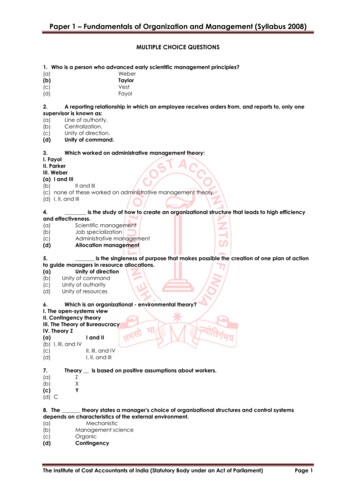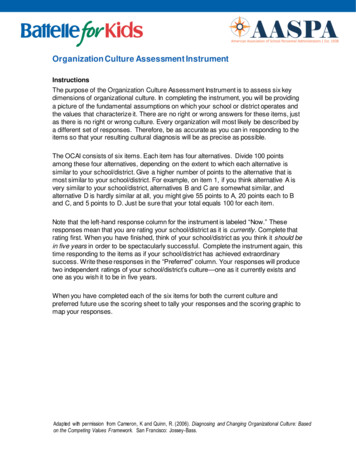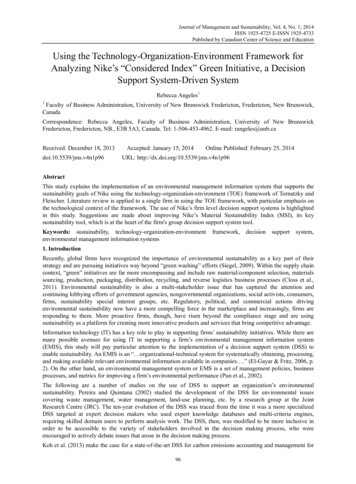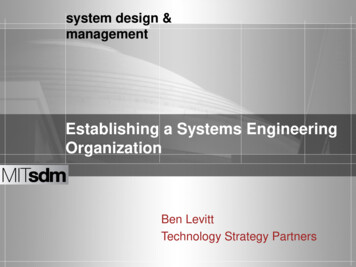
Transcription
Paper 1 – Fundamentals of Organization and Management (Syllabus 2008)MULTIPLE CHOICE QUESTIONS1. Who is a person who advanced early scientific management principles?(a)Weber(b)Taylor(c)Vest(d)Fayol2.A reporting relationship in which an employee receives orders from, and reports to, only onesupervisor is known as:(a)Line of authority.(b)Centralization.(c)Unity of direction.(d)Unity of command.3.Which worked on administrative management theory:I. FayolII. ParkerIII. Weber(a) I and III(b)II and III(c) none of these worked on administrative management theory(d) I, II, and III4.is the study of how to create an organizational structure that leads to high efficiencyand effectiveness.(a)Scientific management(b)Job specialization(c)Administrative management(d)Allocation management5.is the singleness of purpose that makes possible the creation of one plan of actionto guide managers in resource allocations.(a)Unity of direction(b)Unity of command(c)Unity of authority(d)Unity of resources6.Which is an organizational - environmental theory?I. The open-systems viewII. Contingency theoryIII. The Theory of BureaucracyIV. Theory Z(a)I and II(b) I, III, and IV(c)II, III, and IV(d)I, II, and III7.(a)(b)(c)(d) CTheory is based on positive assumptions about workers.ZXY8. The theory states a manager's choice of organizational structures and control systemsdepends on characteristics of the external environment.(a)Mechanistic(b)Management science(c)Organic(d)ContingencyThe Institute of Cost Accountants of India (Statutory Body under an Act of Parliament)Page 1
Paper 1 – Fundamentals of Organization and Management (Syllabus 2008)9.(a)(b)(c)(d)Which is not one of Fayol's principles:Authority and responsibilityLine of authorityGlobalizationUnity of command10.(a)(b)(c)(d)Which is not a management science theory:Operations ManagementTQMMISNone of these11.Theory states that the average employee is lazy and will try to do as little as possible.XYZNone(a)(b)(c)(d)12.In recent history, workers have felt that they should be empowered in the workplace. This isan example of(a) social influences(b) political influences(c) technological influences(d) global influences13. Scientific management, administrative management, and bureaucratic management belong tothe management viewpoint known as the(a) classical perspective(b) behavioral perspective(c) quantitative perspective(d) systems perspective14.The theorist that advocated standard methodology for doing a task and suggestedthat workers were motivated by pay according to output (piecework) is(a) Elton Mayo(b) Max Weber(c) Frederick Taylor(d) Henri Fayol15.As a Theory Y manager, you believe that your employees(a) dislike work and will avoid it if possible.(b) need a hierarchy of authority and lots of rules and regulations.(c) should be trained to standard methodology in all their tasks.(d) are self-motivated and self-directed toward achieving organizational goals.16.What does the case, ‘Scientific management in action’ illustrate?(a) Scientific management theory is an outdated management theory.(b) Managers should apply classical management theory to their everyday work if they want to bemore effective.(c) A traditional approach to management can be successfully applied to the problems of a modernorganisation.(d) Quality usually suffers as productivity increases.17. According to Frederick Taylor, who was to blame for the inefficiency in organisations?(a) The unions.(b) The managers.(c) The organisation as a whole.(d) The workers18. Which of these was not an integral part of scientific management?(a) Differential pay rates.(b) Worker control of production.The Institute of Cost Accountants of India (Statutory Body under an Act of Parliament)Page 2
Paper 1 – Fundamentals of Organization and Management (Syllabus 2008)(c) Systematic selection of workers.(d) Work specialisation19. Which of the following is not a valid criticism of scientific management theory?(a) Increases in pay for workers were not proportional to increases in productivity.(b) Worker discretion over the execution of the task was reduced.(c) Jobs became too complex for workers to handle.(d) Fear of redundancy was increased.20. Which of the following is not a fundamental characteristics of Bureaucratic Management?(a)Specialisation of labour(b)Well defined hierarchy(c)Striving to be a ‘first-class worker’(d)Formal rules and regulations.21.Which of these statements concerning Weber’s concept of Bureaucracy is not correct?(a) It is based on rules and procedures rather than personal preference and judgement.(b) It is still a relevant concept in today’s organisation.(c) It has acquired a negative reputation for inefficiency and rigidity.(d) It rejects rational approaches to managing organizations22. Which of the following was an early key management idea, pre-dating the work of Frederick Taylorand Max Weber?(a) Differential pay rates.(b) Rule-by-the-office.(c) Work specialisation.(d) Classical management theory.23. Which of the following was the key aim of scientific management?(a) To increase worker control of production.(b) To increase productivity.(c) To decrease absenteeism.(d) To develop time-and-motion studies.24. Which of the following is NOT a key concept associated with scientific management?(a) One best way.(b) Formalisation.(c) Time-and-motion studies.(d) Systematic selection.25. Contingency theory suggests which of the following as a limitation of classical managementtheory?(a) Management approaches need to take into account the informal social life of workers at work.(b) Management approaches need to take into account complexity and instability in the environment.(c) Everything is contingent upon the workers in an organisation.(d) Management practices need to recognise stability in the environment.26. Which of the following is NOT true of scientific management?(a) It gave rise to the modern operations research.(b) It raises questions as to how rewards from increased productivity should be distributed.(c) It is outdated as a theory as it cannot be applied to today’s modern organisations.(d) Managers are chosen for their intellectual ability and rationality.27. Which of the following does NOT describe a problem with scientific management?(a) Productivity increases may not be reflected in workers’ pay.(b) It is better suited to complex jobs.(c) Improvement is not necessarily maintainable.(d) It is better suited to simple jobs.28. Scientific management gave rise to which of the following modern disciplines?(a) Theory Y.(b) Behavioural science.(c) Socio-technical systems.The Institute of Cost Accountants of India (Statutory Body under an Act of Parliament)Page 3
Paper 1 – Fundamentals of Organization and Management (Syllabus 2008)(d) Operations research.29. Which of the following men’s writings are associated with bureaucracy?(a) Max Weber.(b) Henri Fayol.(c) Frederick Taylor.(d) Douglas McGregor.30. According to Fayol’s 14 principles of management, ‘esprit de corps’ refers to which of thefollowing?(a) Being treated fairly and kindly.(b) Spirit of the corporation.(c) Team work and harmony.(d) Spirit of work.31. Which of the following images best captures how classical management views the organisation?(a) As an organism.(b) As a human being.(c) As a machine.(d) As a wheel in an engine.32. Which of the following is the ‘odd one out’?(a) Management science.(b) Management accounting.(c) Operations management.(d) Systems management.33. In general, Theory Y and Theory X belong to which of the following perspectives?(a) Socio-political.(b) Bureaucratic.(c) Cultural.(d) None of these.34. Which of the following is NOT part of the mix of behavioural sciences informing organisationbehaviours?(a) Social psychology.(b) Organisational theory.(c) Systems theory.(d) Psychology.35.The behavioural science approaches add which of the following emphases to management?(a) The study of people who satisfy social needs at work and how informal as well as formalorganisation affects behaviour.(b) Management as a science and developing techniques to control behaviour.(c) The scientific study of human behaviour and developing behavioural techniques.(d) None of these.36.ystems theory takes into account which of the following?(a) The whole system of anything.(b) Every system involving humans.(c) Socio-technical systems.(d) Open systems.37.hich of the following phrases is closely connected to contingency theory?(a) No one best way.(b) Today’s ideas are tomorrow’s history.(c) One best way.(d) Universal ideas of good management.38.Which of the following is not a way of overcoming resistance to change?(a) IncentivesThe Institute of Cost Accountants of India (Statutory Body under an Act of Parliament)Page 4
Paper 1 – Fundamentals of Organization and Management (Syllabus 2008)(b) Bullying and harassing people(c) Education and communication(d) Coercion39.Which of the following is the reason for resistance to change?(a) Obsolecense of skills(b) Fear of economic loss(c) Fear of unknown(d) All of the above.40.Changes which take place gradually without any resistance are(a) Evolutionary(b) Revolutionery(c) Planned(d) Unplanned.41.Which of the following is true with people with a Type A personality?(a) They are generally content with their place in the world.(b) They generally fell little need to discuss their achievements(c) They are easy going and relaxed and that’s why take no tension of work.(d) They have an intense desire to achieve and are extremely competitive42.The difference between a company’s mission statement and the concept of strategic vision isthat(a) The mission statement lays out the desire to make a profit, whereas the strategic vision addresseswhat strategy the company will employ in trying to make a profit.(b) A mission statement deals with "where we are headed " whereas a strategic vision provides thecritical answer to "how will we get there?"(c) A mission deals with what a company is trying to do and a vision concerns what a company oughtto do.(d) A mission statement typically identifies what the company's products or services are (what we do)and the customers and markets it serves (why we are here), whereas the focus of a strategic vision is on"where we are going and why."43.The management process functions consist of(a) Planning, organising, staffing and directing(b) Planning, organising, leading and directing(c) Planning, organising, leading and staffing(d) Planning, organizing, leading and controlling.Which of the following is not Kurt Lewin’s famous 3 stage perspective model of change?44.(a) Unfreezing current attitudes(b) Refreezing attitudes at new level(c) Moving to a new level(d) Melting resistance.45.Forcefield analysis suggests that before a manager embarks on a change strategy he shouldproperly identify and evaluate and .(a) Positive forces, negative changes(b) Driving forces, restraining forces(c) External forces, internal forces(d) Strong forces, weak forces.46.Which of the following is not an organ of company management?(a) Officer(b) Board of Directors(c) Managing Director(d) Secretary.The Institute of Cost Accountants of India (Statutory Body under an Act of Parliament)Page 5
Paper 1 – Fundamentals of Organization and Management (Syllabus 2008)47.Disqualifications from becoming a Director of a company is(a) Insolvency(b) Fraudulent, declared by court(c) Unsound mind(d) All of the above.48.The Central Government may appoint some directors for a period of in case ofmismanagement of company affairs(a) 3 and half yrs(b) Not more than 3 yrs(c) 5 yrs(d) Not more than 2 yrs.49.A director has to hold a minimum qualifying amount of shares of withinmonths after his appointment as director.(a) 5000, 2(b) 50,000, 2(c) 5000, 5(d) 5000, 3.The maximum limit of holding Directorship in public companies is50.(a) 11 companies(b) 12 companies(c) 14 companies(d) 15 companies.51.A person cannot be appointed as a Managing Director for more than at a time.(a) 5 yrs(b) 6 yrs(c) 7 yrs(d) 4 yrs52.Which of the following is a characteristic of a Public sector organization?(a) Private ownership(b) Primary profit making motive(c) Strict financial control by Government(d) None of the above.53.Which of the following industries does not come within the purview of 1991 Industrial Policy forreservation for public sector?(a) Handicrafts(b) Atomic energy(c) Arms Ammunitions(d) Coal and lignite.54.Planning is based on:(a) decision-making,(b) forecasting,(c) staffing,(d) organising[Hint: Planning is setting objectives and deciding how to accomplish them.]55.Planning do not consider:(a) choice,(b) communication,(c) machine,(d) coordination.56.Strategic plans are:(a) single use plans,(b) long range plans,The Institute of Cost Accountants of India (Statutory Body under an Act of Parliament)Page 6
Paper 1 – Fundamentals of Organization and Management (Syllabus 2008)(c) for lower management levels.(d) standing plans57.Short-term plans guides:(a) lower level management,(b) bridges gap between past and present(c) forecasting(d) environmental factors58.Participating in the planning process makes:(a) effective planning,(b) cost reduction,(c) increase output.(d) perception of opportunitiesNegative attitude and Commitment are not the basis for:59.(a) effective planning,(b) environment,(c) resistance.(d) technology60.Planning is:(a) looking ahead,(b) guiding people,(c) delegation of authority,(d) fundamentals of staffingSingle use plans are:61.(a) applicable in non-recurring situation,(b) deals with recurring situations,(c) budgets,(d) strategic62.Programs are a complex of:(a) budgets,(b) goals & policies,(c) rules,(d) None of the above.[Hint: Programs are complex of goals, policies, rules, procedures, tasks.]63.The limitations of planning are:(a) proper environment,(b) planning premises,(c) wrong information,(d) feasibility.[Hint: Wrong information and time involved are the limitations of planning.]64.What ar
According to Fayol’s 14 principles of management, ‘esprit de corps’ refers to which of the following? (a) Being treated fairly and kindly. (b) Spirit of the corporation. (c) Team work and harmony. (d) Spirit of work. 31. Which of the following images best captures how classical management views the organisation? (a)











